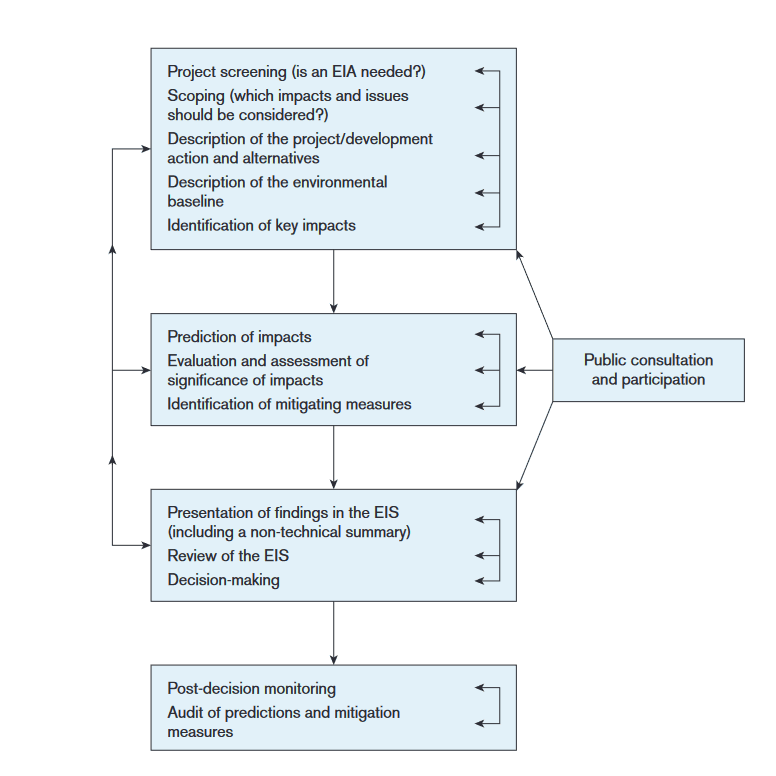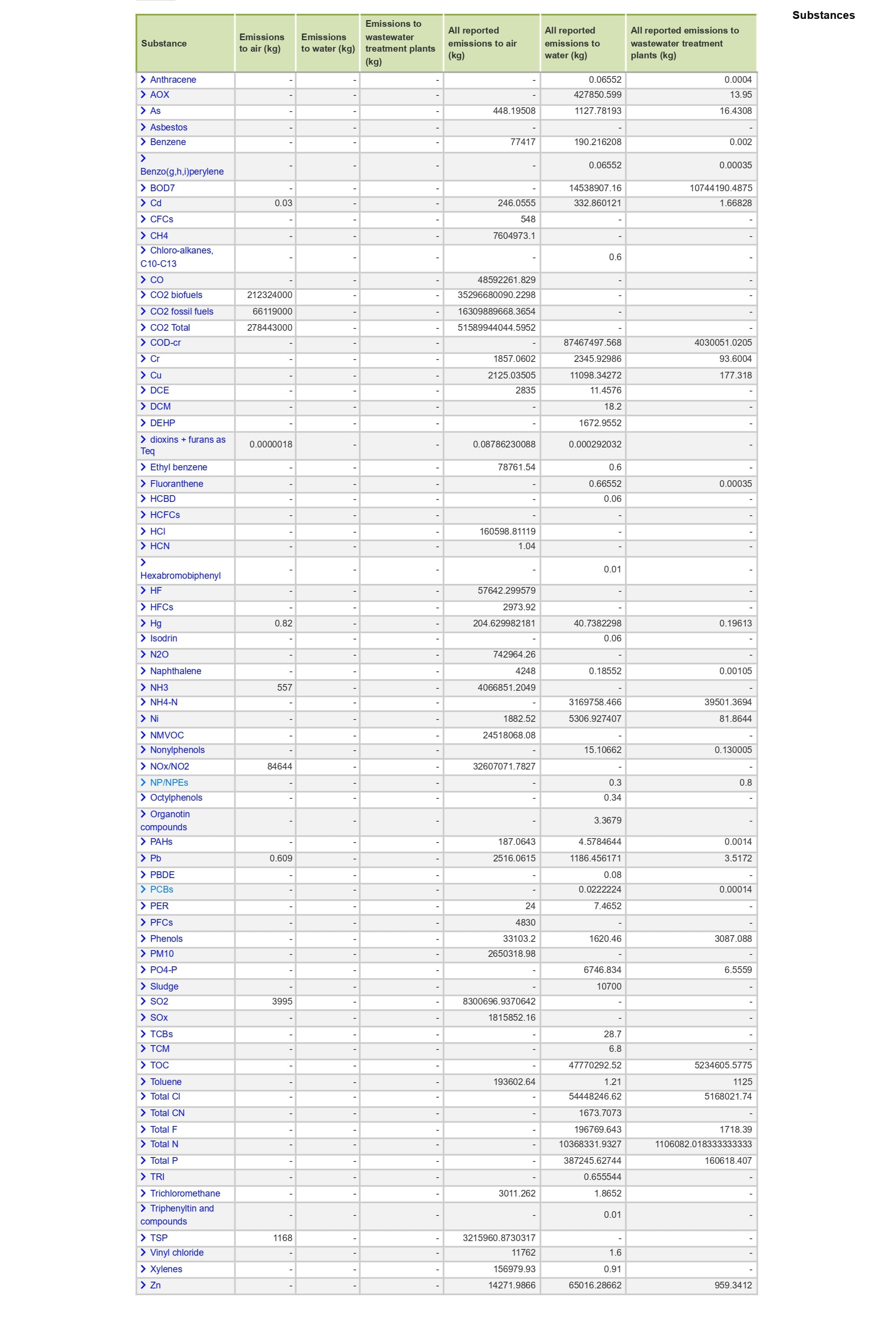Introduction
Environmental impact assessment (EIA) is an essential tool in a worldwide effort to protect the environment. EIA provides a systematic approach for sustainable development, focusing on the balance between economic, environmental costs and benefits. It was created as a reaction originating from environmental concerns in the 1960s (Morgan, 2012), at a time when biophysical, social and health impacts were not considered in most development projects.
EIA Description and History
The International Association for Impact Assessment defines EIA as “the process of identifying, predicting, evaluating and mitigating the biophysical, social and other relevant effects of proposed development proposals prior to major decisions being taken and commitments made” (Glasson and Therivel, 2013). As an aid in decision-making at the early planning stage, EIA’s “systematic, holistic and multidisciplinary way” (Glasson and Therivel, 2013) of assessing development projects makes it a powerful tool for reducing costs and time in project development and design, avoiding expenses related to treatment, clean-up, and complying with environmental laws and regulations (Glasson and Therivel, 2013).
The EIA was officially established in a legislative form by the National Environmental Policy Act (NEPA) (Morgan, 2012) in the USA, 1969 (Glasson and Therivel, 2013). NEPA mandated Federal agencies to develop a publicly available statement of environmental impacts. Other countries have eventually started to implement EIA policy and in 1992, the UN emphasised the importance of EIAs through Principle 17 of the Rio Declaration (Sánchez and Croal, 2012). Currently, most members of the UN “either have national legislation or have signed some form of international legal instrument that refers to the use of EIA” (Morgan, 2012).
In the EU, the first EIA Directive (85/337/EEC) came into force in 1985 and now all member states are required to follow Directive “2011/92/EU as amended by 2014/52/EU” (European Commission, n.d.). The various projects deemed to be assessed by the directive are major development projects that could have a big impact on the environment. The individual EU Member States can decide if other development projects need to conduct an EIA or not (European Commission, n.d.).
In Sweden, the Environmental Protection Agency is responsible for executing the obligations arising from Directive 2011/92/EU, which “is transposed into Swedish legislation mainly by the Environmental Code” (Rosengardten, 2014). The Code’s purpose is to foster sustainable development at a national level, concerning a wide range of environmental aspects, such as “the management of land and water, nature conservation, protection of flora and fauna, environmentally hazardous activities, water operations, genetic engineering, chemical products and waste management” (Thews et al., 2017). The municipal council is responsible for dealing with minor environmental issues and the County Administrative Board is handling matters that are beyond the local scope but do not require the specialised expertise of the Environment Courts (Thews et al., 2017).
Aspects of EIA through the Case Study
EIA is a long back-and-forth process and varies from country to country (Glasson and Therivel, 2013). To explore and clarify Sweden’s EIA system, I will focus on Dåva Combined Heat and Power (CHP) plant as a case study.

Figure 1. EIA shown as a cyclical process. Each step influences and interacts with the other ones (Glasson and Therivel, 2013).
During the construction of Dåva 1 and 2, built in 2000 and 2010 respectively (“Umeå’s CHP Plant Sets New Standard in Turning Waste into Power | News,” n.d.), Sweden was already a member of the EU (The Swedish environmental code, 2000), which implies that the plant underwent an EIA process. Although the specifics of Dåva’s EIA are not easily accessible, some aspects of it can still be speculated. As explained in the EUFJE Conference 2014 (Rosengardten, 2014), Sweden’s EIA process goes through the following steps:
- Screening: a process of filtering the projects deemed to have considerable environmental impacts (Glasson and Therivel, 2013).
Dåva CHP Plant, property of Umeå Energi, has therefore undeniably engaged in public consultations and local authority deliberations. As a waste-to-energy facility, Dåva falls under the category of projects with significant environmental impacts both in ANNEX I of Directive 2011/92/EU and Chapter 9 Section 6 of the Swedish Environmental Code.
- Scoping: aims to pinpoint at an early phase the key and significant issues deriving from impacts and possible alternatives of a project (Glasson and Therivel, 2013).
According to the Code, the developer should make an Environmental Impact Statement (EIS) which should include the following:
- “a description of the activity or measure with details of its location, design and scope” (The Swedish environmental code, 2000)
Dåva CHP Plant is located 9km NE of the centre of Umeå in the North of Sweden. Being the city’s main source of energy, the plant was built due to the increasing need for sustainable heating and electricity in the area. Dåva 1 produces energy from dry waste, having an incineration capacity of 20 tonnes/h (“Umeå’s CHP Plant Sets New Standard in Turning Waste into Power | News,” n.d.). Dåva 2 uses biofuel in a fluidized-bed combustion boiler with a water content of about 38-54 % (Umeå Energi, 2019).
- “a description of the measures being planned with a view to avoiding, mitigating or remedying adverse effects” (The Swedish environmental code, 2000)
Dåva is diametrically opposite the airport from the city, thus avoiding accidents and congested pollution. Being 9km NE away from the city centre, the plant’s site is perfect for reducing air pollution effects on Umeå’s residents. Moreover, an advanced filter system mitigates the plant’s emissions, purifying 99.5% of acidified gases and 99.5% of particle-bound contaminants (“Umeå’s CHP Plant Sets New Standard in Turning Waste into Power | News,” n.d.).

Figure 2. (Windfinder.com, n.d).
The location of Dåva ensures sufficient noise reduction without jeopardising the efficiency of heat transport. The direction of the main air current and the forests surrounding the plant contribute to reducing the noise from the plant as measured in the city.

Figure 3. The daily average noise from the plant does not reach the city (“Umeå Kommun Webbkarta,” n.d.).
Dåva’s placement is also transport efficient. It is next to E4 highway, which goes from the Swedish border with Finland to South of Sweden along the coast. Additionally, the biggest number of houses are in the northern half of Umeå, optimising the length of district heating pipes and reducing the travel for waste collector trucks.
- “the information that is needed to establish and assess the main impact on human health, the environment and management of land, water and other resources” (The Swedish environmental code, 2000)
Dåva can have direct and indirect effects on climate change. The direct effects are that it produces CO2 and NOx, which are the main components of greenhouse gases. Indirect effects come from the supply chain: trucks emit CO2 while transporting residues to the CHP plant.

Figure 4. Substance emmisions from Dava CHP Plant (“Substance list,” n.d.)
- “a description of possible alternative sites and alternative designs, together with a statement of the reasons why a specific alternative was chosen and a description of the consequences if the activity or measure is not implemented” (The Swedish environmental code, 2000)
If all environmental aspects are considered, such as topography, wind direction, city density and location of other buildings with major environmental impacts, Dåva’s current spot is the best one possible.

Figure 5. District heating has lower environmental impact compared to individual heating (Umeå Energi, 2019)
Dåva is the main producer of Umeå’s district heating supply, which offers several benefits compared to conventional energy production. It uses less fuel, by reducing energy losses in transmission and distribution, resulting in lower emissions and pollutants (US EPA, 2015).

Figure 6. A comparison example between the efficiency of CHP plants and conventional ones(US EPA, 2015)
- Decision making: comprises of an evaluation by the appropriate authority of the EIS (Glasson and Therivel, 2013).
After submitting the EIS, the Environment Court issued an EIA that underwent public consultation. Given that all aspects were addressed, the EIA is subjected to a public plan for observations before implementation.
- Post-decision monitoring: entails documenting the outcomes and impacts of the development once the project is underway, ensuring efficient management (Glasson and Therivel, 2013).
Currently, Dåva 1 has an energy output of 55 MW for district heating and 10 MW for electricity, supplying with heat about 18,000 average-sized homes for a full year and with electricity approximately 6,500 homes (“Umeå’s CHP Plant Sets New Standard in Turning Waste into Power | News,” n.d.). The number of homes in Umeå 2022 was 70,500 (“Bostäder — OpenDataUmea,” n.d.). Dåva 2 produces around twice as much energy, 75 MW for district heating and 30 MW for electricity. Their efficiency is very good, 94% and 95% respectively (“Umeå’s CHP Plant Sets New Standard in Turning Waste into Power | News,” n.d.). The Swedish EPA is constantly monitoring industrial emission pollutants, including from Dåva, ensuring that these are kept in the threshold limits (“Search in the Swedish PRTR,” n.d.).
- Auditing: used to evaluate the accuracy of predictions and the success of mitigation, an essential component in the learning process of the EIA (Glasson and Therivel, 2013).
At this step, changes can be made to the project to achieve the country’s environmental objectives.

Figure 7. (“Swedish environmental objectives,” n.d.)
In 2017, Sweden implemented a new climate policy framework, aligning with the Paris Agreement. This framework aims for net-zero emissions by 2045 (“Sweden’s Climate Act and Climate Policy Framework,” n.d.). In line with Sweden’s commitment to the goal, plans to build an e-methanol plant at Dåva have started. The facility will produce 100,000 tons of green e-methanol and capture 230,000 tons of CO2 annually. It is predicted that electrofuel can reduce carbon dioxide emissions by over 90% (Ajdin, 2023).
Conclusions
Integrating EIA early in the planning phase allows for faster and easier adaptation to local environmental conditions, improving “relations between the developer, the planning authority and the local communities; to a smoother development consent process” (Glasson and Therivel, 2013).
However, the effectiveness of EIA relies mostly on national environmental laws and objectives. Biases, inconsistent data quality, and diverse global standards can impact its framework.
References
Ajdin, A., 2023. Third e-methanol plant on the cards for Sweden [WWW Document]. Splash247. URL https://splash247.com/third-e-methanol-plant-on-the-cards-for-sweden/.
Bostäder — OpenDataUmea [WWW Document], n.d. URL https://opendata.umea.se/pages/bostader/?flg=en-gb.
European Commission, n.d. Environmental impact assessment [WWW Document]. URL https://environment.ec.europa.eu/law-and-governance/environmental-assessments/environmental-impact-assessment_en.
Glasson, J., Therivel, R., 2013. Introduction To Environmental Impact Assessment, 4th ed. Routledge, 2 Park Square, Milton Park, Abingdon, Oxon OX14 4RN.
Morgan, R.K., 2012. Environmental impact assessment: the state of the art. Impact Assess. Proj. Apprais. 30, 5–14. https://doi.org/10.1080/14615517.2012.661557
Rosengardten, A.-L., 2014. Impact Assessments – Preventive Measures against Significant Environmental Impacts in the 21st Century- Sweden. Presented at the EUFJE Conference 2014, Budapest.
Sánchez, L.E., Croal, P., 2012. Environmental impact assessment, from Rio-92 to Rio+20 and beyond. Ambiente Soc. 15, 41–54. https://doi.org/10.1590/S1414-753X2012000300004
Search in the Swedish PRTR [WWW Document], n.d. URL https://utslappisiffror.naturvardsverket.se/en/Search/.
Substance list [WWW Document], n.d. URL https://utslappisiffror.naturvardsverket.se/en/Search/Substance-list/?pid=4594.
Sweden’s Climate Act and Climate Policy Framework [WWW Document], n.d. URL https://www.naturvardsverket.se/en/topics/climate-transition/sveriges-klimatarbete/swedens-climate-act-and-climate-policy-framework/.
Swedish environmental objectives [WWW Document], n.d. URL https://www.naturvardsverket.se/en/om-miljoarbetet/swedish-environmental-objectives/.
The Swedish environmental code, 2000. , Ds : departementsserien, 2000:61. Fritzes offentliga publikationer, Stockholm.
Thews, B., Höjding, P., Jansson, B., 2017. Swedish Environmental Law : An introduction to the Swedish legal system for environmental protection (No. 978-91-620-6790– 8 (ISBN)), Rapport / Naturvårdsverket. Naturvårdsverket, Stockholm.
Umeå Energi, 2019. A short introduction to Umeå Energi and Dåva CHP.
Umeå Kommun Webbkarta [WWW Document], n.d. . Umeå Kommun Webbkarta. URL https://kartor1.umea.se/karta/Miljo/Buller/Bullerkarta2016.
Umeå’s CHP Plant Sets New Standard in Turning Waste into Power | News [WWW Document], n.d. . Smart City Swed. URL https://smartcitysweden.com/best-practice/216/umeas-chp-plant-sets-new-standard-in-turning-waste-into-power/.
US EPA, O., 2015. CHP Benefits [WWW Document]. US EPA. URL https://19january2021snapshot.epa.gov/chp/chp-benefits.
Windfinder.com, n.d. Windfinder.com – Wind and weather statistic Umeå Airport [WWW Document]. Windfinder.com. URL https://www.windfinder.com/windstatistics/umea.